- Table of Contents
- 1. Introduction:
- 2. Isle of the Man TT:
- 2.1 History
- 2.2 The first race on the Isle of Man
- 2.3 The Isle of Man TT
- 2.4 Map
- 2.5 List of Dangerous Turns on the Isle of Man TT:
- 2.6 Crowd:
- 2.7 Fastest Lap Records
- 2.8 Fatalities
- 2.9 Causes of Death in the Isle of Man TT:
- 3. Erzberg Rodeo
- 4. Dakar Rally
- 5. La Baneza Road Race
- 6. Gold Cup Oliver’s Mount Scarborough
- 7. Daytona
- 8. Ulster Grand Prix
- 9. Macau Grand Prix
- 9.1 Introduction
- 9.2 History
- 9.3 Fatalities
- 9.4 Why is the Macau Motorcycles Grand Prix is Dangerous?
- 10. North West 200
- 11. Pikes Peak International Hill Climb
- 11.1 Introduction:
- 11.2 History:
- 11.3 Why Motorcycles are Banned?
- 11.4 Fatalities:
- 11.5 Causes of Death:
- 12. Conclusion
1. Introduction:
Motorcycle racing is not a new thing that started a few years or a decade ago instead there are several motorcycle races that are being held since the early 1900s. Some of them are the deadliest and most extreme races in the world. Extreme races are those races that do not have any limit on the vehicle speed and some extreme races also include off-road races and hill-climb races. There are several national and international motorcycle races held in different countries all over the world, that includes local public races, rally races, etc. but these are limited to the locals or the residents of the same country.
However, in this article, the races that are discussed are international racing events, in which hundreds of thousands of people gathered from all over the world to watch and participate as well. With extreme rules also comes extreme risks as well. Every year the organizers of all the races mentioned below try to make safety as best as possible but every year there have been several accidents occur and some fatal accidents also lead to the death of the riders.
Here is a list of the world’s most extreme and deadliest races with their detailed history and other useful information.
2. Isle of the Man TT:

Photo Credit: @fineartamerica.com
2.1 History
Isle of the Man TT (Tourist Trophy) is the oldest, deadliest, and MOST DANGEROUS motorcycle race. In 1903, the speed limit on the British highways was set at 20 mph, with local towns being requested to implement lower speed limits on their nearby highways. Around the same time, races started being held in Europe. However, there were no proper racing tracks, so races were held on public roads, making the 1903 British Speed Limit Act a hindrance for racers. Sir Julian Orde, the secretary of the Automobile Club of Great Britain and Ireland, thought this new act would stop the advancement of performance-oriented-vehicles. So, he persuaded the Isle’s government to allow him to conduct an automobile race for the advancement of English automobiles. The Manx authorities allowed Orde to host a race.
2.2 The first race on the Isle of Man
In 1904, the first car race was set on the Isle of Man, which turned into a huge success. However, the people wanted more speed, thrills, and danger. So, the very next year, motorcycles were introduced to the race. The racers and organizer made some guidelines, deciding that the race would host two classes: single-cylinder machines that averaged 90 mpg and twin-cylinder machines that averaged 75 mpg, along with other regulations regarding saddles, mudguards, etc. In May 1907, the inaugural International Auto-Cycle Tourist Trophy took place, which eventually became known as the Isle of Man TT.
2.3 The Isle of Man TT
In 1911, the race course was extended to 37.7 miles called the Snaefall Mountain Course, this new course also introduced a new class, the Junior TT. This class was open to the 300-cc single-cylinder and 340-cc twin-cylinder motorcycles. This class was a four-lap race, with the five-lap race being for the senior class only. During the same year, the first death occurred on this track. A racer, Victor Surridge, was killed while trying to overtake another racer, but because of the wide distance and high speed, he crashed into a ditch. According to the medical teams, Surridge died on impact. Since then, 280 deaths have occurred on that track, including racers and even spectators as well.
2.4 Map
Riders have to cover six laps, with each lap being 37.7 miles in length. The track contains over 300 turns and the competitors race at a breakneck speed averaging 130 mph. The Sulby Straight is the fastest section of this 37.7-mile TT course. This is the section where the average speed is 200 mph, with the tire barely touching the road because of the many crests and bumps in the road.

Photo Credit: @bennetts.co.uk
2.5 List of Dangerous Turns on the Isle of Man TT:
Ballacraine to Ballig Bridge is one of the darkest roads due to the low sunlight.
Black Dub and Union Mills are very narrow and have dangerously sharp turns.
Cronk-y-Voddy and Sulby Straight are some of the straightest roads on this course, with speeds reaching dangerously high. There are bumps and crests on the road, which often cause the motorcycle to only have one tire touching the ground.

Photo Credit: @bennetts.co.uk
Bishop's Court to Alpine Cottage is one of the most beautiful roads of the whole course because of the trees and greenery on either side of the road.
There is a turn at Conker Fields that is especially dangerous because even during daytime, there is low visibility due to the long shadow cast by the trees on either side of the road.
From Tower's Bend and onward, there are dangerous turns because this part of the course takes place on a mountain and there may be ditches on the other side of the corners. Even the turns at Mountain Box are dangerous because of the weak fence lining the sides of the road.
2.6 Crowd:
Over the years, the Isle of Man TT continued to attract record-breaking crowds. In 2019, the largest crowd yet recorded was over 46,000 spectators. Every year, spectators get the chance to see the fastest and craziest riders participate in the rawest race in the world.
2.7 Fastest Lap Records
| Category | Rider | Motorcycle | Year | Average Speed | Time |
|---|---|---|---|---|---|
| Outright | Peter Hickman | BMW S1000RR | 2018 | 135 mph | 16 mins 42 secs |
| Superbike TT | Dean Harrison | Kawasaki | 2018 | 134 mph | 14 mins 50 secs |
| Supersport TT | Micheal Dunlop | Yamaha R6 | 2022 | 129 mph | 17 mins 29 secs |
| Lightweight TT | Paton | 2018 | 122 mph | 18 mins 26 secs | |
| Ultra-lightweight TT | Chris Palmer | Honda RS125 | 2004 | 13% mph | 20 mins 20 secs |
| Sidecar TT | Ben Birchall and Tom Birchall | Honda CBR Sidecar | 2018 | 119 mph | 18 mins 59 secs |
2.8 Fatalities
Among the 280 deaths, 110% people died officially practicing or participating in the race, including the riders killed during the Manx Grand Prix and Clubmen TT race series of the 1940s and 1950s. The Manx Grand Prix was an amateur version of the Isle of Man TT, while the Clubmen TT was a class for motorcycles under production from 1947 till 1956. These classes were intended to help new riders climb the ranks, which meant professional racers of the Isle of Man were not allowed to participate in these classes. These racing classes ended badly for many new riders, resulting in several accidents that ended in death. The deadliest year was 2005, with a total of 11 fatalities.
| Year | No. of Deaths |
|---|---|
| 1911 to 1952 | 42 |
| 1953 to 1972 | 58 |
| 1973 to 1992 | 65 |
| 1993 to 2012 | 74 |
| 2013 to 2022 | 26 |
2.9 Causes of Death in the Isle of Man TT:
Speed:
The main cause of deaths in the Isle of Man TT is sports motorcycle riding at high speed which makes it difficult to turn and results in crashes when clearing corners.
Low-Security Measures:
The organizers implemented many safety measures to reduce the rate of fatalities. Sadly, these measures were implemented after Frank Bateman died in 1913. From this point forward, helmets were mandatory. In 1927, a rider named Archie Berkin died during practice by colliding with a fish van. From 1928 and onwards, the races started being held on closed public roads. In 1934, another rider crashed due to intense fog that blocked his vision. Later in 1936, organizers implemented weather delay policies.
Unexpected Hurdles on the Road:
Some accidents occur due to spectators crossing the road and colliding with riders or trash on the road causing riders to lose control.
3. Erzberg Rodeo
3.1 Introduction
Erzberg Rodeo is a motorcycle enduro event conducted in Austria every year during May or June. First held in 1995, some motorcycle enthusiasts tried to tackle the Earth’s Berg, the world’s largest man-made pyramid. It is also an active iron ore mine. Over the years, the mountain has been shaped into a more pyramid-like shape.
Over the years, many racing stars have come and go from the Erzberg Rodeo. But the race organizer and inventor Karl Katoch has remained a part of the tradition. Currently, the Erzberg Rodeo is a four-day event because of the huge number of riders who participate every year. The importance of the Erzberg Rodeo was beautifully quoted by one of the locals, “You see, we live four days a year and feed on it for the other 361 days.”
3.2 History
In 1995, Karl Katoch founded the Erzberg Rodeo race. Katoch and his fellow riders were overwhelmed by the sheer backdrop of Earth’s Berg, so they all took a quick ride over that mountain. At first, there were very few racers, only about 20 to 30 who organized this hard enduro race. But over the years, the Erzberg Rodeo attracted around 200 riders.
3.3 Map

Photo Credit: @moto1pro.com
The riders are given four hours to complete a 35 km race track, consisting of steep climbs, narrow passages through the forest, steep muddy tracks, and traveling over rock. The first three riders who cross the finish line are considered the winners of the race. On this racing track, there are several points where riders can get stuck, which only experienced, professional riders can get out of.
3.4 Fatalities
According to a survey conducted in 2009, around 3,000 riders participated in the Erzberg Rodeo, and only 6% of them got into accidents. The overall average injury scale was 2.8, around more than 80% of all accounted injuries were exterior.
Accidents that occurred during the Erzberg Rodeo were due to the front or rear tire slipping, resulting in injuries to the arms and legs. However, in 2015, an onlooker was killed by a falling rock. According to eyewitnesses, the rock fell from a height of 300 meters. By the time the rescue helicopter and paramedics arrived, the man was already dead at the scene.
Although the Erzberg Rodeo is the toughest enduro race in the world, there are rarely any fatalities. However, several superficial injuries do occur during the race.
3.5 Prize:
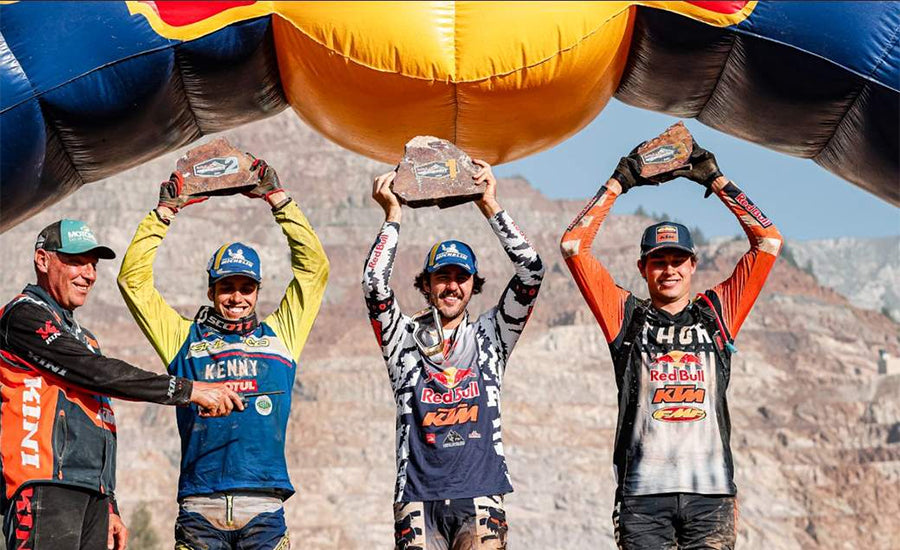
Photo Credit: @enduro21.com
There is no cash reward for winning the Erzberg Rodeo. The winners only receives a piece of rock from the Earth’s Berg.
4. Dakar Rally
4.1 History
The history of the Dakar Rally began in 1977. Thierry Sabine, a French motorcycle racer, got lost in the Libyan Desert during the Abidjan-Nice Rally, but managed to return to France. After sharing his fascinating journey with other riders, Sabine designed a route starting in Paris to Alger, Alger to Tamanrasset, Tamanrasset to Agadez, Agadez to Niamey, Niamey to Gao, Gao to Bamako, Bamako to Nioro, and finally to Dakar.
On December 26, 1978, 182 vehicles gathered in Paris for the inaugural race, for a 10,000 km journey into the unknown. These 182 vehicles included motorcycles, cars, trucks, etc. In 1986, the Dakar Rally lost its founder after Sabine’s helicopter crashed into the dunes of the Sahara Desert during a sandstorm. Over the years, the Dakar Rally has been organized in different regions around the world.
From 1978-2008, the map of the rally made by Thierry Sabine remained the same, spanning across 24 countries from Europe to South Africa. Due to security concerns, the race was canceled in 2008. The following year, the venue was set in South America.
From 2009-2019, the map of the Dakar Rally started in South America. The race crossed almost all of South America, spanning Argentina, Chile, Peru, Bolivia, and Paraguay. Each year, around four million people gathered to watch the competitors race.
In 2020, Saudi Arabia offered all competitors a chance to cross the mountains, giving riders the opportunity to explore this new area.
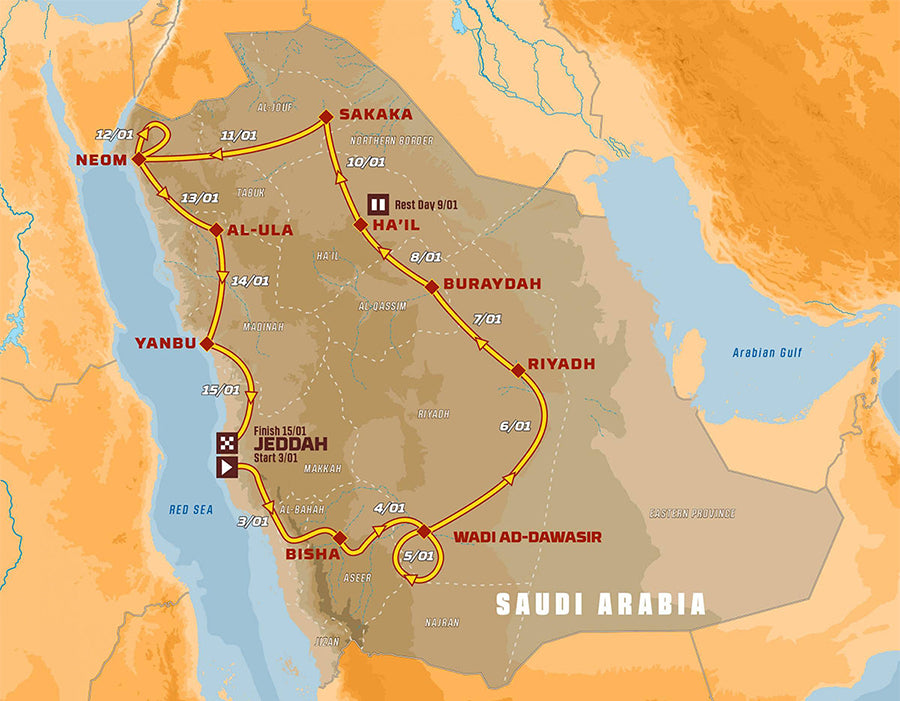
Photo Credit: @saudigazette.com.sa
4.2 Fatalities
Since the first Dakar Rally, 76 people have died, including competitors and non-competitors.
| Competitors | 31 | Motorcyclist | 23 |
| Car Driver | 4 | ||
| Truck Driver | 1 | ||
| Rebel Conflict | 2 |
| Non-Competitors | 45 | News Journalists and Crew | 14 |
| Spectators | 23 | ||
| Children | 4 |
4.3 Causes of Death
Type of road:
The Dakar Rally includes both on- and off-road racing, including deserts, beaches, mountains, and rocky areas. There have been many accidents when vehicle tumbled over while trying to clear a turn.
No safety fence:
In the first iteration of the Dakar Rally created by Thierry Sabine, there were several locations with no safety fence or any kind of safety precautions for the spectators.
Lack of visibility:
The Dakar Rally includes off-road areas, meaning a lack of visibility on dirt roads. Due to the amount of dirt kicked up, visibility while looking through a helmet becomes blurry. It is also difficult for riders to see when riding at speeds around or above 100 mph.
Losing control:
There have been numerous accidents, recorded and unrecorded when riders lost control of their vehicles when they jumped over a bump or were turning at high speed.
5. La Baneza Road Race
5.1 History
La Baneza Road Race was first held in Leo, Spain in 1952; since then, it has been held every year in August. It has a smaller racing track of 1.75 miles but is full of narrow turns. This is a competition between 125 cc Moto-3 motorcycles. This race is conducted in northwest Spain, in the province of Castille. For the first two years 1952 and 1953, the race was held unofficially but as more and more people gathered to watch the event was officially conducted as La Baneza Grand Prix in 1954. According to survey in 2017 around 60,000 spectators gathered to watch the event. In the same around 100 riders participated in the race.
5.2 Introduction:
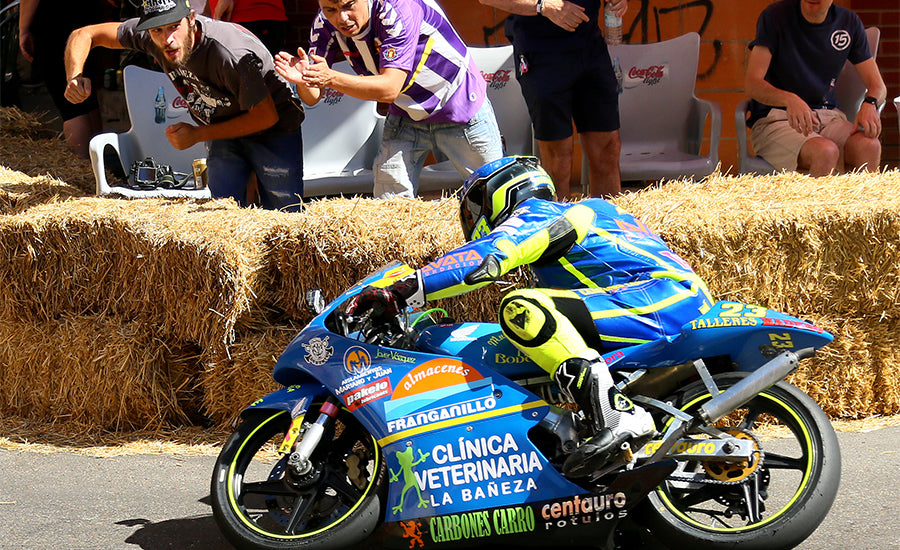
Photo Credit: @amcn.com.au
This La Baneza Road Race is held on public roads. According to the latest count in 2021, around 60,000 people were in the crowd beside the racing track enjoying the action. For the locals, this is more than just a race. No competitor earns money from this competition, even the people who organize this event do so voluntarily. The locals are very humble, opening their homes voluntarily for racers and spectators alike. This race is fun because the locals get to contribute.
5.3 Fatalities
In 1985, a spectator died in an accident, being the only death that occurred in the La Baneza Road Race’s history. Injuries and accidents do happen, but there have been no other fatalities so far. Still, this race is one of the most dangerous because of its narrow and twisted race track.
Why is the La Baneza Road Race one of the most dangerous motorcycle races in the world?
Although there has been only one death occurred yet but there have been several fatal accidents occurred during the La Baneza Grand Prix, resulting in competitors and non-competitors being injured. Other than the braking zones like turns, hairpins, and finish line, riders keep an average lap speed of more than 140 mph. This racing track has one of the tightest hairpin turns in the whole U.K. The narrow road and tight hairpin turn make La Baneza Grand Prix one of the most dangerous motorcycle races in the world.
6. Gold Cup Oliver’s Mount Scarborough
6.1 Introduction
Oliver’s Mount is located in Scarborough, North Yorkshire. It is an elevated area that overlooks Scarborough. Oliver’s Mounts was named after Oliver Cromwell, who supposedly had placed guns there, but there is no proof that Cromwell ever visited Scarborough.
The first motorcycle race held at Oliver’s Mount was in 1946. Still held to this day, Oliver’s Mount is the only street circuit race in England. The number of spectators who attend Oliver’s Mount can reach up to 58,000.

Photo Credit: @en.wikipedia.org
The circuit is 3.91 km (2.43 miles) long with straight and twisty turns that can only be tackled by skilled riders. Before 2018, the races at Oliver’s Mount were organized by the Auto 66 Club. In 2019, ownership of the race was given on lease to GrantRoberts Ltd. The Barry Sheene Classic Race is held on July 27 and 28 and the Gold Cup Race is held on September 27 to 29.
6.2 Fatalities
There have only been six deaths that occurred during the Oliver’s Mount Race, along with the occasional light or serious injuries.
| 1968 | John Hartle | Collision with a rider. |
|---|---|---|
| 1974 | Phil Haslam | Died by striking the steel frame of the bridge. |
| 1983 | Bob Smith | Hit by a rider. |
| 2002 | Mark Lingard | Lost control |
| 2012 | Steven Hix | Lost control |
| 2016 | Billy Redmayne | Lost control |
6.3 Causes of Death:
Slipped and Hit
- John Hartle was the first rider to die during the Oliver’s Mount Race on August 31, 1968. During his final lap, Hartle tried to take third place. Traveling too fast, he collided with a slower rider who was dealing with mechanical issues. He survived the initial impact, but then hit the metal frame of the pedestrian bridge.
- In 1974, a British rider, Phil Haslam, died after hitting the steel frame of the bridge. After successfully clearing a hairpin turn, Hartle was slowing down the motorcycle and coming around the edge of the track when his handlebars were clipped by another rider, and he hit the steel edge.
- In 1983, another famous British rider, Bob Smith, died on this track. In his third lap at the first hairpin turn, he slipped and was thrown into the fence with his motorcycle. As he bounced back on the track, he was run over by another motorcycle. He was immediately brought to the hospital but died of cardiac arrest.
Lost Control
- In 2002, Mark Lingard died on Oliver’s Mount due to losing control of his Kawasaki 600. Though he was a skilled rider, he could not control his motorcycle and crashed. He suffered several severe chest injuries, sadly passing away on July 14, 2002.
- In 2012, another British rider, Steven Hix, could not control his motorcycle, which was riding at a speed of 120 mph, and caused tank slappers (the heavy oscillation of the motorcycle handlebars at high speed), resulting in him getting into a fatal crash.
- In 2016, Billy Redmayne, a full-time member of the Parachute Regiment, died due to getting into an accident at Oliver’s Mount. While climbing the hill at a very high speed, Redmayne lost control of his Kawasaki ZX-10R and crashed into some trees. He suffered severe head injuries and died two days later at James Cook University Hospital in Middlesbrough.
7. Daytona
7.1 History
Daytona is one of the most renowned races in the world. The Daytona International Speedways are located in Daytona Beach, Florida. The first race at Daytona Beach was held in 1937. The event started at a 3.2-mile beach and road course located south of Daytona Beach. The original beach course ran approximately two miles south along South Atlantic Avenue from the starting line near Ponce Inlet, onto the beach around a packed-sand banked turn, then headed 1.5 miles north along the beach up to the north turn to start the next lap. Ed Kretz of Monterey Park, CA won the first race, averaging 74.34 mph on an Indian model. Kretz also won the inaugural City of Daytona Beach trophy.
On February 24, 1947, the Daytona 200 took place on the beach and was promoted now by the legendary Bill France of NASCAR. The 1947 Daytona 200 had a record high of 176 riders participating.
After a string of four straight wins by the British brand Norton, Harley-Davidson came roaring onto the scene in 1953 with a victory by Paul Goldsmith, beginning a decade of dominance on Daytona Beach, including seven straight wins from 1955 to 1961. The last race held on Daytona Beach was in 1960.
In 1961, the Daytona 200 moved to the brand new Daytona International Speedway built by Jim France. Roger Reiman won the first race at the Daytona International Speedway on a Harley-Davidson model.
After several years of Harley-Davidson victories, Harley Davidson racing team rider Cal Rayborn won the Daytona 200 by a full lap, averaging 101.290 mph. His vehicle was the first motorcycle to average over 100 mph in the history of Daytona.
7.2 Map
The Daytona International Speedways have multiple track layouts for different types of races.

7.3 Fatalities
The Daytona International Speedways are dangerous because at higher speeds, many riders cannot maintain control over their motorcycles. As there is no speed limit for the Daytona, many riders try to finish the race as soon as possible. Hence, accidents can occur while making sharp turns, because if a rider skids, the other behind may also collide, causing a chain of riders to fall off their vehicles.
Here is a list of riders who have died during the Daytona:
| YEAR | RIDERS | CAUSE OF DEATH |
|---|---|---|
| 1969 | Wayne Harris Bartz | Crashed into two wrecked motorcycles |
| 1971 | Rusty Bradley | Lost control of motorcycle |
| 1988 | Randy Glenn | Lost control of motorcycle |
| 1993 | James Adamo | Front brake failed |
| 1997 | Roger Reiman | Collision of several motorcycles. |
| 1997 | Chad Matteson | Crashed motorcycle |
| 2000 | Chris Tato | Crashed motorcycle outside retaining wall |
| 2001 | Dirk Piz | Collision with crashed motorcycle |
| 2001 | Stuart Stratton | Collision with the wall |
| 2003 | Bryan Cassell Jr. | Hit by another rider, Jeff Tatham |
| 2013 | Eric Desy/Risk Shaw | Collided into each other and died on the same day |
7.4 Causes of Death:
Collisions with other motorcycles
- Wayne Harris Bartz was the first rider to die during the Daytona 200 in 1969. During the first lap, two riders collided and fell. Bartz was right behind them, colliding with the two riders and was thrown 30 ft into the air. Bartz died of severe neck and chest injuries and a fractured skull.
- In 2001, Dirk Arthur Piz hit another rider’s motorcycle. He hit a hay bale barrier, rupturing his aorta. Bartz passed away later in a hospital.
Lost control
- Joseph Russel “Rusty” Bradley was the second rider to die in the Daytona 200. After clearing the first corner turn, Bradley lost control of his motorcycle, suffering a severe neck injury that killed him almost instantly.
- In 1988, Randy Glenn died during the Daytona 200. He was an amateur rider riding a Kawasaki 500 EX, a more powerful motorcycle than he had ever operated previously. Glenn lost control of his motorcycle, suffering severe head injuries, and died at the scene.
- In 1993, James “Jim” Charles Adamo lost control of his motorcycle because the front brake failed and hit a concrete wall with a steel guard rail.
- In 1997, Roger Reiman died during a practice session. A rider lost control of his motorcycle, causing the riders behind him to collide, causing a chain reaction. Roger Reiman was among the riders involved in the accident and died due to the fatal crash.
- Chad Mattenson and Christophe William Tatro’s deaths were interesting cases because no one saw or knew exactly how they died.
8. Ulster Grand Prix

Photo Credit: @ulstergrandprix.net
8.1 History
The Ulster Grand Prix was created by Harry Ferguson in 1922. After watching a car race, Ferguson was inspired to start a race for motorcycles? He shared his idea with his friends, one of them being Thomas Moles, who was part of the Ulster Unionist Party at that time, also happened to be a motorcycle lover. The first Ulster Grand Prix was held at the old Clady Circuit. The old Clady Circuit was where the event was hosted until the 1930s. In 1935, it was renamed as the Grand Prix de Europe. However, no races were held during World War II. In 1948, the Grand Prix was held on a shorter track that was only 16.6 miles long.
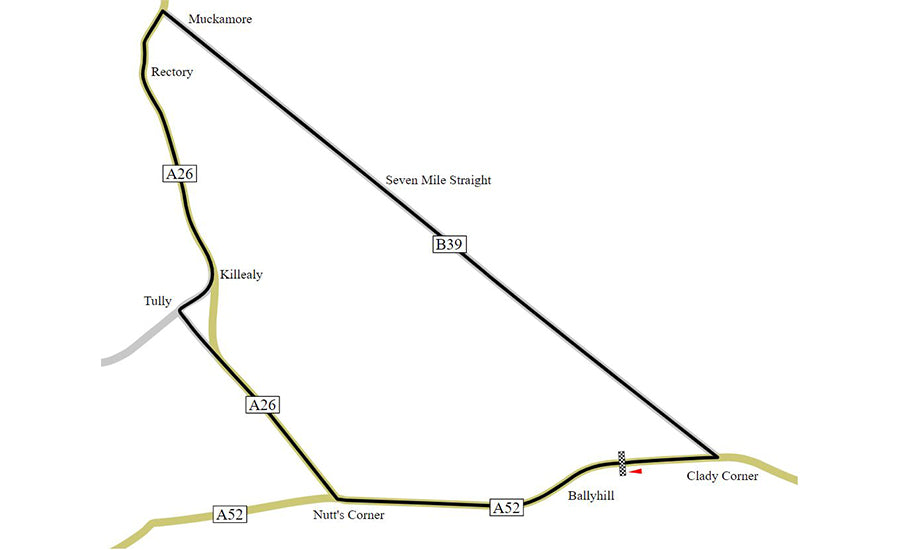
Photo Credit: @en.wikipedia.org
In 1950, the Belfast Industry Club decided to run the Ulster Grand Prix event on the newly made Dundrod Circuit. After three years, the organizers realized they could not hold two different races on two different circuits. So, they decided to conduct both races on the Dundrod Circuit.
Ulster Grand Prix saved in 1963
Despite the fact that the Ulster Grand Prix attracted a huge crowd and skilled riders, it was on the verge of financial collapse in 1963. Thankfully, a man named Dez Jordan set up a club that supported the Ulster Grand Prix, raising enough money to save the event and ensuring it would continue to be held.
In 1970, a bomb destroyed the Grand Prix House, resulting in the 1972 Ulster Grand Prix being abandoned and replaced with shorter races held at Bishop’s Court. Another consequence of the bombing was that the world championship status was revoked from the Dundrod Circuit in 1973. Yet the Ulster Grand Prix continued to be heldbecause many talented local riders took part in the race. Northern Irish riders were dominating on the roads and the circuits. This attracted big international names to come and try to compete with them. From the mid to late 1970s, famous names like Tom Herron, Joey Dunlop, and Ray McCullough began to win races. From 1978 to 1990, the Ulster Grand Prix also hosted the Formula 1, 2, and 3 Championships.
Some Remarkable wins
- In the mid 1990s, Philip McCallen took three wins in 1993, four wins in 1994, and five wins in 1996. In 1999, David Jeffery became the first superbike rider to win on their debut after narrowly beating Joe Dunlop. This defeat inspired Joe Dunlop to pursue his first win while riding a superbike. To this day, Dunlop holds the most wins in the Ulster Grand Prix’s history, having achieve 24 total wins.
- From the early to mid 2000s, Bruce Anstey dominated the superbike class. In 2006, Guy Martin won both superbike and super sports races. In 2006, Belfast Telegraph sponsored the races when a lack of funding threatened to cancel the Ulster Grand Prix, allowing the event to continue being held as normal.
- From 2010 to 2018, Michael and William Dunlop, Guy Martin, Bruce Anstey, Dean Harrison, Ian Hutchinson, and Peter Hickman took part and won in the Ulster Grand Prix. Dean Harrison secured the fastest average track record of 134.614 mph. Until 2018, the Ulster Grand Prix was the fastest motorcycle road race in the world. In 2018, Peter Hickman secured the fastest lap speed record of 135.452 mpg at the Isle of Man TT. But in 2019, Peter Hickman beat his fastest lap speed record by reaching 136.4 mph in the Ulster Grand Prix.
8.2 What Happened to the Ulster Grand Prix?
- The last Ulster Grand Prix was held in 2019. In 2019, the organizers revealed that they were in a debt, being required to pay 300,000 pounds that they had working towards for months, holding meetings with the Northern Ireland government councilors and other officials, but failed to get the required funding. In 2021, it was announced that the clerk of the course, Noel Johnson, was to resign. It was also revealed that Peter Hickman received a lower cash prize than he was promised and other riders did not get paid as much as they should have.
- In 2021, another announcement was made that the Ulster Grand Prix would return in 2022 and the organizers have dealt with their financial issues. Peter Hickman said he would happily return once he and his fellow riders got what they were owed. In 2019, BBC reported that the organizers received 255,000 pounds from government funding by the sports minister, Paul Gibbon, in 2017. This money was to be used to upgrade the circuit’s safety features to reduce the risk of injuries and fatalities. However, the majority of the funds was used to improve building facilities, including a refurbished clubhouse, a shower, and a toilet block. Of course, the club denied any mismanagement of funds and claimed the money was used to improve the paddock and track.
- In March 2022, news spread that the funding needed for the Ulster Grand Prix had been denied by the northern Ireland tourism board. The Northwest 200 and Ulster Grand Prix had previously secured an 800,000-pound security package that would hopefully secure the future of both events. Both were organized by the same organization Ulster Grand Prix Supporters Club and the Dundrod and District Motorcycle Club and funding needed to be approved by two departments Northern Ireland local government and Northern Ireland Tourism board. It was the tourism department who blocked funding for the Ulster Grand Prix, claiming that it was six times more than the funding provided in 2019.
8.3 Causes of Death
By the time the last race was held at Dundrod Circuit, 20 deaths had occurred, 17 of them being competitors, two were race officials, and the last fatality was a spectator.
| YEAR | RIDER | CAUSE OF DEATH |
|---|---|---|
| 1955 | Julian Crossley | Died in a crash |
| 1956 | Derek Ennett | Slipped on wet road at 100 mph |
| 1961 | Ronald L.Miles | Motorcycle struck embankment and caught fire |
| 1977 | George Oates | The sidecar went out of control when Oates took a sharp turn at 75 mph and struck the grass bank, both riders suffered injuries. Oates died on the day of the accident, Molyneux died two days after the accident |
| John Molyneux | ||
| 1978 | Jermery M.Swann | The rear wheel of Swann’s motorcycle was hit, causing it to go out of control and crash |
| 1978 | John Williams | Lost control of the motorcycle at a corner turn |
| 1986 | Stephen Smyth | Collided with the wreckage of a crashed motorcycle and died instantly |
| 1987 | Klaus Klein | Crashed due to aquaplaning |
| 1992 | Steve Johnson | Collided with another rider |
| 1995 | Martin Murphy | Lost control of sidecar, Murphy died instantly while the passenger, Mark Graham, survived with a broken arm |
| 1997 | Steven Galligan | Lost control of sidecar, went over a ditch, and plowed into the crowd |
| 1999 | Owen McNally | Crashed at Dawson’s Bend, a right-hand corner near the start-finish line at 130 mph. Died of severe head injuries |
| 2002 | Gary Jess | Lost control of motorcycle and was hit by another rider while falling off the motorcycle |
| 2004 | Andy Wallace | Crashed into five other motorcycles. Died instantly on the scene, other riders survived with injuries |
| 2015 | Andy Lawson | Lost control of motorcycle at Deer’s Leap section |
| 2018 | Fabrice Miguet | Lost control of motorcycle at the fourth lap. Died two days after accident |
Non-competitors who have died during the Ulster Grand Prix:
| YEAR | NAME | ROLE | RACE |
|---|---|---|---|
| 1961 | Quarry Bends | Race Marshall | 500cc Race |
| 1997 | Christopher Mac Connell-Hewitt | Spectator | Sidecar Race |
| 2001 | Gerald Allaways | Flag Marshall | 600cc Race |
After the 1997 incident, when seven-year-old spectator Christopher Mac-Hewitt died when the sidecar attached to Steven Galligan’s motorcycle crashed into the crowd, the sidecar was no longer allowed in the Ulster Grand Prix. However, Galligan also died of his injuries 10 days after the incident.
9. Macau Grand Prix
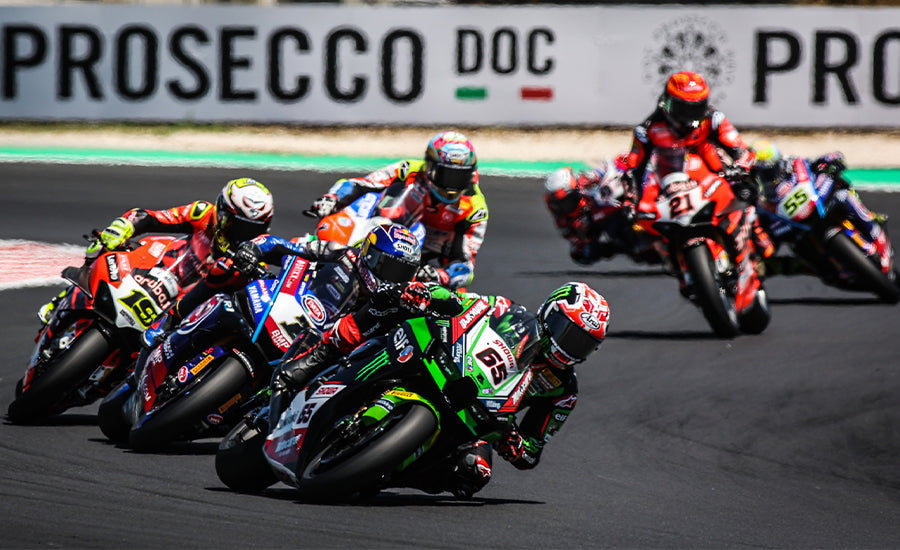
Photo Credit: @worldsbk.com
9.1 Introduction
The Macau Grand Prix is a road race for both automobiles and motorcycles. It is held annually in Macau, China. The first race was held in 1954, being a sports car event. In 1957, production cars took part in this event; later being replaced with touring cars in 1972. The main highlights of this event are the Macau Motorcycle Grand Prix and Macau Formula Three Grand Prix. The Macau Grand Prix is one of the few races that involves both cars and motorcycles.
The Macau Grand Prix is usually held from Thursday to Sunday on the second or third week of November. The first two days (Thursday and Friday) are generally for practice and qualifying. The races are held on Saturday and Sunday of the same week.
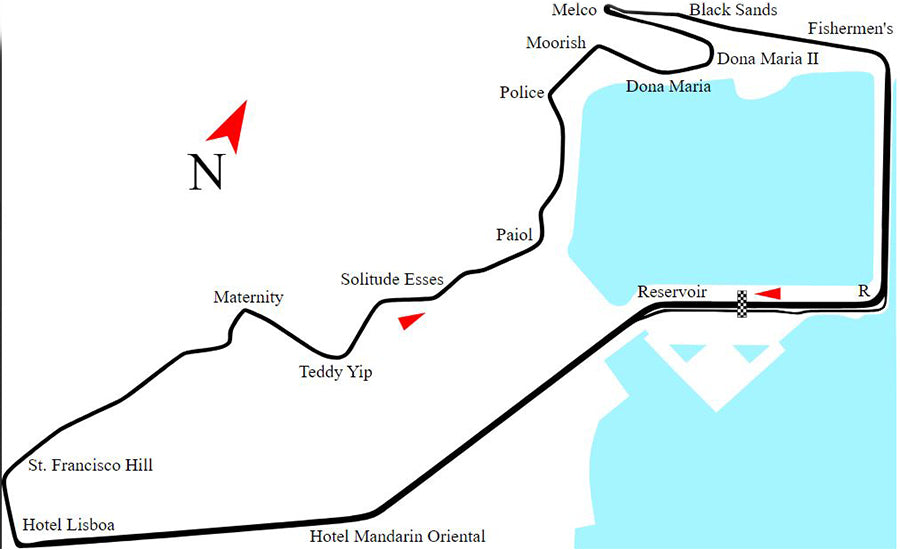
Photo Credit: @en.m.wikipedia.org
9.2 History
Motorcycles were first introduced in the Macau Grand Prix in 1967, the same year Dodjie Laurel died after losing control of his car. This tragedy raised questions about the safety of the riders. Teddy Yip was one of the organizers behind the Macau Grand Prix in the 1970s and 1980s. Yip was a businessman and the owner of a Formula One team in the 1970s.
Since Formula Pacific was becoming outdated, the organizers decided that the race would be held as a F3 event. Initially, they wanted to host an F2 event, but it would have required cutting down more trees to modify the track. So, the organizers settled on a F3 event for the race.
9.3 Fatalities
There have been a total of 17 deaths at the Macau Grand Prix, nine motorcyclists, five car drivers, one spectator, one official, and one bystander. Out of all these 17 fatalities, eight of them were from Hong Kong.
List of motorcycle death fatalities:
| YEAR | NAME | ROLE | RACE |
|---|---|---|---|
| 1961 | Quarry Bends | Race Marshall | 500cc Race |
| 1997 | Christopher Mac Connell-Hewitt | Spectator | Sidecar Race |
| 2001 | Gerald Allaways | Flag Marshall | 600cc Race |
9.4 Why is the Macau Motorcycles Grand Prix is Dangerous?
The Macau Grand Prix is a street race with very narrow streets that are dangerous for high-speed motorcycles. Most deaths occurred on this track due to the riders hitting the guard rails or the walls. Other than the narrow streets, there were also very tight turns that resulted in riders crashing while turning at high speeds.
10. North West 200
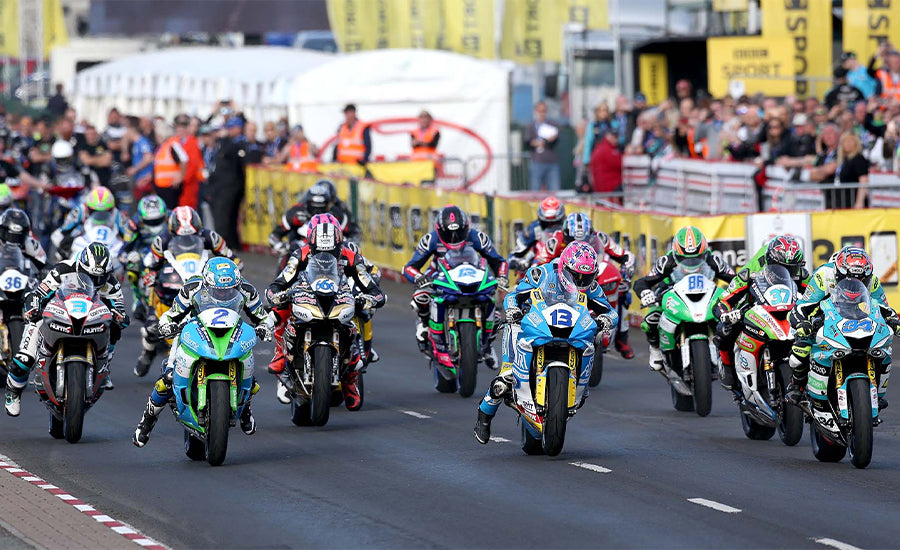
Photo Credit: @twitter.com
10.1 Introduction
In the 1920s, there were no racing circuits built in Northern Ireland. Following the success of the Ulster Grand Prix and the Isle of Man TT, the organizers at the Darien District Motor Club proposed a new race that would be held in the woods around Londonderry.
The event became known as the North West 200 because the race was held in Northwest Ireland over 200 miles and an 11-mile course with 20 laps. The organizers hoped to use the event as a way for manufacturers to test their vehicles and attract big names. The location was later changed; instead of being around Londonderry, the race track now consisted of woods connecting Portrush, Portstewart, and Coleraine. These three points formed what would later be known as the Triangle Circuit.
10.2 History
The first race was held on April 20, 1929, being won by W.J. McCracken on his 348-cc Velocette within three hours, eight minutes, and 35 seconds. In 1930, the finish line was moved from Magherabuoy to the Portmore Wood and Portrush. In 1934, Jimmy Guthrie was the first to complete the first lap at a speed over 80 mph.
Races were held every year until they were temporarily discontinued during World War II. The North West 200 resume being held in 1947. The event was again discontinued in 1948 due to a fuel shortage. The North West 200 finally returned in 1949 on its 20th anniversary. In 1949, the largest number of entries in the North West 200 were recorded with a total of 113 entries.
In 1957, Jack Brett was the first to reach the 100 mph speed limit while riding on his Norton. The North West 200 became difficult to manage due to a lack of trade support and well-known entries. The event was canceled again in 1963. The Coleraine District Motor Club took over the event’s organization in 1964. Races resumed and Honda took their first win in the North West 200, the company’s rider Ralph Bryan winning in the 350 cc and 250 cc classes.
In 1972, due to troubles in the northwest, the troubles were related to the conflicts between predominantly Catholic Ireland and predominantly Protestant England, the conflict went so high that there were bombing in the Northern Ireland. It was concern that any major public event could be a target for terrorists. Therefore, due to pressure by the government, the North West 200 was called off again. Major changes were done to the circuit in 1973, with the start/finish line being moved between Juniper Hill and Millbank Avenue. The Portstewart Promenade section was also removed and the York corner was introduced to the circuit.
In 1978, Tom Herron made a new lap record of 127.63 mph while riding a superbike. Until 2003, this was the fastest lap record on any British circuit. In 1979, Joey Dunlop won his first victory, but Tom Herron, Brian Hamilton, and Frank Kennedy sadly lost their lives. In 1979, the Shell Hill Bridge was considered a part of the course for the last time. A road linking University Corner and Ballysally Roundabout was included in the North West 200’s route in 1980. In 1983, the Juniper Hill chicane was made a part of the course as well. Robert Dunlop took his first win in northwest 200 in 1986 in the 350-cc series, it was the first of many victories that Robert made later on. In 1988, another chicane was added to the course at the start/finish line, allowing safe access to the pit stop lane.
In 1992, Philip McCallen made history by winning five races in a day. A third chicane was introduced between round about and the metropole, it was designed to slow the riders on the long fast road. 2000 was the last year when Joe Dunlop took part in the northwest 200 and won both superbike races. The event was once again canceled in 2001. The event was canceled again due to foot and mouth disease. In 2004, Michael Rutter was the first rider to reach a top speed of 200 mph and ended up winning the superbike race. This speed record was again broken in 2012 by Martin Jessop, who reached a top speed of 208 mph.
10.3 Causes of Death
There have been 19 deaths that occurred throughout the North West 200’s history, with most riders suffering from the fatal arm, leg, chest, and head injuries.
Here is the list of fatalities that occurred in the North West 200:
| YEAR | RIDER | CAUSE OF DEATH |
|---|---|---|
| 1939 | Norman Wainwright | Lost control of his Norton 500 when the front tire blew off while riding at 70 mph, the front rim struck a curb, and flew off the bike. Hit his head against a gate pillar into a field and was killed instantly |
| 1949 | P.L. Phillips | Lost control of his AJS 350 and crashed into a stone pillar. He died due to shock and lacerations in the brain |
| 1951 | William Bennison | Lost control of his motorcycle at high speed and fell on the road, this accident also caused nine other riders to crash. Was among the injured riders and died later on the same day |
| 1956 | Bill Aislabie | Died after getting into an accident while practicing |
| 1970 | Andy Manship | While trying to take the lead while riding at 100 mph, lost control of the motorcycle. Rolled about 15 yards before hitting a concrete post |
| 1973 | Graham Fish | Lost control of motorcycle, clipped a hay bale on the inside right side of the track and fell into a ditch on the left side of the track |
| 1979 | Brian Hamilton | Involved in a pile-up in which two riders were hurt. Later died in a hospital |
| Tom Herron | While trying to overtake another rider, slipped on damp or wet road, fell and struck a lamp, and later died in a hospital on the same day. | |
| Frank Kennedy | Collided with a fellow rider and motorcycle blew up. was in a coma for six months before succumbing to injuries | |
| 1980 | Mervyn Robinson | Crashed at high speed |
| 1982 | John Newbold | Crashed into a wall, died in a hospital on the same day as the accident |
| 1986 | Pat McLaughlin | Crashed and suffered fatal injuries while riding at 100 mph. Died three days later in Coleraine Hospital |
| 1987 | Steve Bull | Lost control of motorcycle and crashed while riding at 120 mph. Died a week later after the accident |
| 1999 | Donny Robinson | Crashed motorcycle during a practice session and eventually succumbed to injuries. |
| 2008 | Robert Dunlop | Motorcycle seized up and was thrown over handlebars while riding at 160 mph. Suffered severe chest injuries and died in a hospital |
| 2009 | Mark Young | Got into a fatal accident while exiting Mather’s Cross, suffered from fatal leg and chest injuries |
| 2012 | Mark Buckley | Crashed at the Mill Road roundabout, was brought to a hospital where he died during the same afternoon |
| 2014 | Simon Andrews | Lost control of his BMW S1000RR. Was brought to the Royal Victoria Hospital where he died two days later without regaining consciousness |
| 2016 | Malachi Mitchell-Thomas | Fell from motorcycle while riding at 110 mph and slid on the road about 90 feet before hitting a bale wall. Was conscious after the accident and died about 40 minutes later despite efforts to try and save his life |
How Dangerous is the North West 200?
The North West 200 is dangerous because of its narrow and steep turns, with most accidents occuring at corner turns. There are many straight roads where riders can race at maximum speed, but trying to make a narrow turn at high speeds can become problematic for riders.
The North West 200’s race track is especially dangerous after heavy rainfall. Rain often falls in Northern Ireland, with several accidents occurring due to riders aquaplaning while riding at high speeds. Steve Bull met a tragic end due to riding on a wet course at high speed while taking part in the North West 200.
11. Pikes Peak International Hill Climb
11.1 Introduction:
Pikes Peak International Hill Climb (PPIHC) is most commonly known as “The Race to the Clouds.” This race track is located in Colorado Springs, USA. The first Pike Peaks International Hill Climb was held in 1916, this race including motorcycles and cars. This track is 19.99 km (12.42 miles) long, has around 156 turns, starts from a height of 4,720 ft (1,440 m), and finishes at a height of 14,115 ft (4,302 m). Of the 99 Pikes Peaks races, motorcyclists have only participated in 41 of them.
11.2 History:
At first, motorcyclist were allowed to participate in the PPIHC until the 1920s, there were no motorcycle races on pikes peak between 1920 and 1954, according to locals it was because of security reason but the actual reason is still unclear, then the motorcycles were allowed to return in 1954 and 1955. Again from 1956 to 1970 there was no motorcycle race. In 1971 the local motorcycle deals gathered and decided to continue the motorcycle races on Pikes Peak and this time three divisions were introduced 125, 250, and open, the motorcycle races continued from 1971. Then after a pause till 1991, the motorcycles returned to racing. The reason behind this pause was because of the death of a motorcyclist Bill Gross who fell during the race and while trying to lift his motorcycle back up and start it, he was hit by another competitor. He died on the 4th of July, 1982. The motorcycle races again continued after 1991.
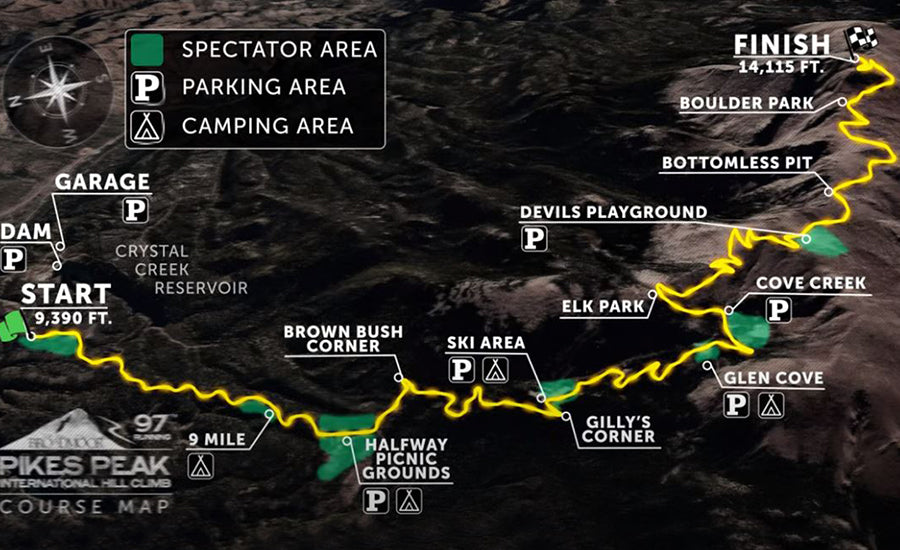
Photo Credit: @motorcycmagazine.grandprix.co.th
11.3 Why Motorcycles are Banned?
In 2019, a motorcyclist named Carlin Dunne died near the finish line. When making the final turn towards the finish line, he hit a bump and lost control, falling 20 to 30 feet into an embankment. To prevent more motorcycle fatalities, the organizers of the Pikes Peak International Hill Climb banned the participation of motorcycles.
11.4 Fatalities:
There have been seven fatalities throughout the history of the Pikes Peak International Hill Climb:
| YEAR | RIDER | CAUSE OF DEATH | Vehicle Type |
|---|---|---|---|
| 1921 | Wallace Coleman | Lost balance during a turn | Car |
| 1982 | Bill Gross | Collision with another rider | Motorcycle |
| 2001 | Ralph Chandler Bruning | Fell through an embankment | Car |
| 2005 | Henry J. Bresciani | Collision with another car | Car |
| 2014 | Bobby Goodin | Slipped over outcropping rocks | Motorcycle |
| 2015 | Carl Sorensen | Fell from cliff | Motorcycle |
| 2019 | Carlin Dunne | Crashed close to the finish line | Motorcycle |
This motorcycle race is dangerous because the course includes 156 narrow turns on tight roads. With each turn, there is likely an embankment or a deep slope on the other side.
11.5 Causes of Death:
Slipping:
- In 2014, another rider named Bobby Goodin lost control of his motorcycle on the gravel parking lot right after crossing the finish line. He lost control of his Triumph 675R Daytona and fell over a bunch of boulders. He suffered severe chest injuries and died an hour after the accident at a hospital.
Fell from a cliff:
- An American rider, Carl Sorensen, died in 2015 right before the finish line. While riding a Kawasaki 2013, Sorensen lost control of his motorcycle and fell off a cliff just as he was about to cross the finish line.
- The most recent death that occurred at the Pikes Peak International Hill Climb was in 2019. An American motorcyclist, Carlin Dunne, cleared the last turn toward the finish line. While pushing the motorcycle forward, Dunne hit a bump and flew right over his motorcycle, and fell 20 to 30 feet down into an embankment.
- In 2001, Ralph Chandler Bruning Jr. lost control of his car and fell into an embankment about 20 to 30 feet deep. Sadly, a tree penetrated through his car’s window, suffering chest and neck injuries that killed him instantly.
- In 1921, Wallace Coleman became the first fatality of the Pikes Peak International Hill Climb. While attempting a reverse camber hairpin turn, Coleman plunge over a bunch of boulders, bouncing around and getting pinned under his car. Coleman’s chest was crushed, his back was broken, and his skull was also fractured, killing him instantly.
Collision with another rider:
- Bill Gross was the second motorcyclist to die in the Pikes Peak International Hill Climb. He lost control of his motorcycle and fell. After wrecking his motorcycle, Gross managed to stand back up and tried to lift his motorcycle back up. But as he began to do so, Gross was hit by another rider who was blinded by the dust kicked up. Gross died before the paramedics could arrive at the scene. He died on July 4, 1982.
- Henry J. Bresciani was the first non-competitor to die in the Pikes Peak International Hill Climb’s history, Bresciani was the flag swinger for the event. When he was waving for the riders approaching the finish line, Bresciani was struck by a car driven by Jay Stewart. Henry died on June 21, 2022 at the age of 67.
12. Conclusion
All of the above-mentioned races are the most extreme and deadliest races because there is no speed limit to these races and a large number of riders have died during these races. Isle of Man TT is considered the world’s deadliest race because 280 deaths have occurred till now on that track. Erzberg Rodeo on the other hand is the toughest motorcycle race mainly because of its track that is full of slopes, off-roading, and forest. Erzberg Rodeo is also a DIRT MOTORCYCLE race. Dakar rally is one of the longest races in the world. It is also one of those races which include desert, on-road track, and off-road track. La Baneza Grand Prix is dangerous because of its narrow street and tight turns although there has been only one death fatality on this track. But many accidents have occurred on this track. Gold Oliver’s Mount race is one of the most dangerous tracks for motorcycles because of its steep and hairpin turns. Ulster Grand Prix and Nort West 200 both races are conducted in Northern Ireland. However, the Ulster Grand Prix is conducted on a proper racing track while the Nort West 200 is conducted on public roads with required arrangements. Macau Grand Prix is a dangerous motorcycle race because of its narrow streets and tight corner turns. Pikes Peak International Hill Climb has now banned motorcycles from being a part of this race because this race is extremely dangerous for motorcycle riders mainly because of the track, the track is around a mountain and there are several points on that track where the opposite side is 20 to 30 feet deep ditch, if any rider happens to fall from the cliff, they will most likely not survive.
All of the fatalities that have occurred in motorcycle races are due to riders losing control of their motorcycle, the motorcycle slipping while turning, mechanical issues, collisions with other riders, wet roads, etc.
The list can go on, but there are steps that can be taken to help reduce the number of motorcycle fatalities. The road must be clear and clean, with no oil leaks on the road. It should offer traction so that the tires do not slip. The riders should fit their motorcycles with a new pair of tires, check the brakes, and ensure the motorcycle engine is in working condition. Every rider is required to be fully equipped with proper riding gear, including helmets, jackets, gloves, etc. Riders can attach bags to carry necessary items that they may need in case of emergencies The type of motorcycle luggage bags can vary between motorcycles. For SPORTS MOTORCYCLES, SADDLEBAGS, TANK BAGS, and HANDLEBAR BAGS are the best options. For DIRT MOTORCYCLES, riders can mount SADDLEBAGS, TANK BAGS, HANDLEBAR BAGS, and TAIL BAGS. For CRUISER MOTORCYCLE, riders have many options like SADDLEBAGS, SISSY BAR BAGS, SWING ARM BAGS, TANK BAGS, TRUNKS, HANDLEBAR BAGS, TAIL BAGS, etc.








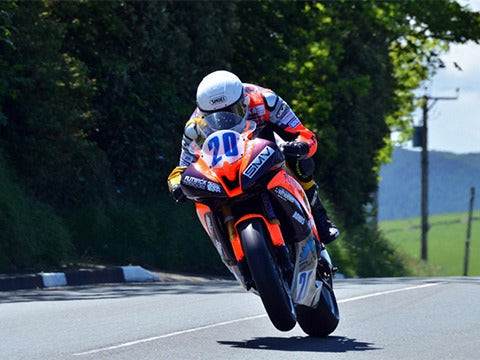



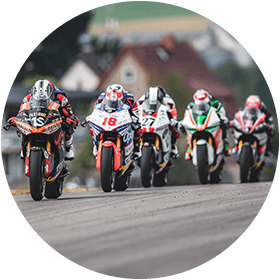


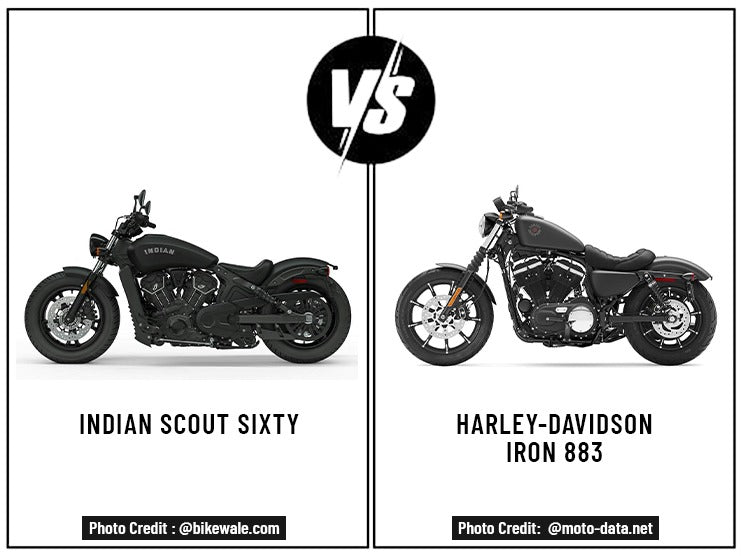

Leave a comment
All comments are moderated before being published.
This site is protected by reCAPTCHA and the Google Privacy Policy and Terms of Service apply.